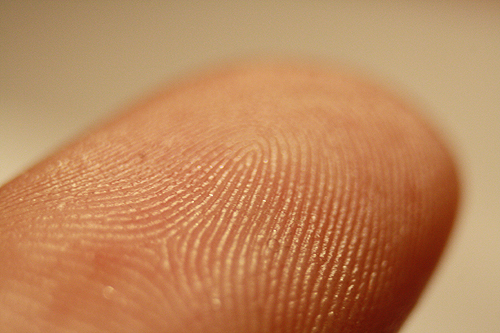Comparing Fingerprints
by Andrew Boyd
Today, who dunnit? The University of Houston's College of Engineering presents this series about the machines that make our civilization run, and the people whose ingenuity created them.
"The defendant's fingerprints were found at the crime scene." Seems simple enough. Fingerprints at the crime scene were found and compared with the defendant's. They matched.

But exactly what do we mean by "matched"? It takes engineering, math, and a little ingenuity to answer that question.
Fingerprints come from ridges on the skin. These ridges form patterns. Loops. Arches. Whorls. If one print shows a loop and another a whorl, they came from different people. But if two prints both show loops, they may or may not have come from the same person. To find out, we need to take a closer look.

The ridges on our fingers do all sorts of strange things. They split. They come to an end. They form islands. These are the minutiae — a technical term in the world of fingerprints. We claim two fingerprints are the same if we can count enough minutiae that match.

In a perfect world we'd want a perfect match. But a fingerprint taken from a door handle usually isn't perfect. So we're willing to accept "enough" matches. And here's where the math comes in.
We want enough matches to make the chance of a mistake very, very unlikely — say, one in a million billion. And most mathematical models predict a chance this small or smaller with around a dozen matches. So many fingerprint experts use this "twelve-match guideline" — plus or minus a few matches. When a fingerprint expert takes the witness stand and says he's absolutely certain two fingerprints match, he means he's found about twelve or more matching minutiae.
The math is sound. But we've discovered problems can arise — most coming from the quality of the fingerprints. If one or both aren't very good, mistakes can be made.
A disturbing example occurred in 2004 — the now famous Madrid Error. A fingerprint found in a Spanish train bombing was compared against a database of fingerprints. Computers found one that looked like a good match. Four experts asserted with "absolute confidence" that it belonged to a lawyer in Oregon. But they were wrong, as they found out when the actual bomber was apprehended.
What caused the mistake? The crime scene fingerprint wasn't perfect. But there was something else, too. The print wasn't checked against a small list of possible suspects; it was checked against a huge database of 500 million fingerprints. That meant there were 500 million chances to find a close match. The computer did just that. It was so close, four separate people made a mistake.
Fingerprints remain an excellent way to identify people. But it's always healthy to remind ourselves. Neither computers — nor human experts — are perfect.
I'm Andy Boyd at the University of Houston, where we're interested in the way inventive minds work.
For a related episode, see FINGERPRINTS.
Fingerprint Identification. Taken from the Thin Blue Line web site -- no longer active
The Madrid Error. Taken from the Fingerprint Identification Based on Likelihood Ratio, Match Probability & Relevant Fingerprint Population web site (no longer active). Contains pictures of the fingerprint taken from the crime scene, the print of the bomber, and the print of the incorrectly identified lawyer.
Matching Fingerprints: Solving Crimes, Improving Security. Taken from the National Institute of Standards web site.
J. Thornton. "Setting Standards in the Comparison and Identification." Transcript of a presentation given at the 84th Annual Training Conference of the California State Division of the International Association for Identification. Laughlin, Nevada. May, 2000.
The fingertip picture is from Wikimedia Commons, the picture of loops, whorls, and arches is from the nist.gov web site, and the picture with various fingerprint minutiae labeled is from the biometrics.gov web site.